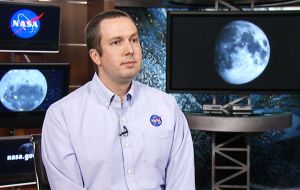MercoPress. South Atlantic News Agency
Supermoon, the closest since 1948, and won't be repeated until 2034
 The moon travels in an oval-shaped orbit around Earth, but on average, the natural satellite is about 384,400 kilometers away, according to NASA.
The moon travels in an oval-shaped orbit around Earth, but on average, the natural satellite is about 384,400 kilometers away, according to NASA.  “This one is historically close,” said NASA scientist Noah Petro. “The moon hasn't been this close to the Earth since January of 1948.”
“This one is historically close,” said NASA scientist Noah Petro. “The moon hasn't been this close to the Earth since January of 1948.” This month's bright supermoon — the closest full moon in 68 years — is expected to light up the sky early Monday morning, NASA has reported. Every year, scientists and sky watchers welcome the supermoon, which is the closest full moon of the year. But this year, the supermoon is receiving extraordinary attention.
“This one is historically close,” said NASA scientist Noah Petro. “The moon hasn't been this close to the Earth since January of 1948.”
The moon travels in an oval-shaped orbit around Earth, but on average, the natural satellite is about 384,400 kilometers away, according to NASA. November's supermoon will venture a bit closer to the planet, leaving only 356,508 km between Earth and the moon, Live Science's sister site Space.com reported. That distance is measured from the center of Earth to the center of the moon.
Granted, the space between Earth and the moon will still be vast — it's equivalent to the height of about 28 Earths — but the slightly closer approach will make a difference for sky gazers. The moon is predicted to appear up to 14% larger and 30% brighter than the smallest full moon, Petro said.
While the casual observer may not notice a difference in brightness, people who regularly watch or photograph the moon will likely appreciate the “difference in size of the moon as it goes in its orbit around the Earth,” Petro said.
The supermoon will be closest to Earth at 6:22 a.m. EST on Monday, but it won't be at its fullest until 8:52 a.m. EST, a time that's after “moonset” for most of the United States, NASA said.
But even if you miss that “full moon moment,” the moon will be nearly full for most of Sunday night (Nov. 13) and even Monday night (Nov. 14), providing prime watching time for the public, Petro said.
He advised going to a dark viewing area to catch the lunar show. “Find a clear space where you're free, certainly of bright lights, but even [of] tall buildings or trees that will obstruct your view, especially when the moon is low in the sky,” he said. “Later on at night, when the moon is high in the sky, any spot is going to be fine.”
Petro noted that as the moon approached the perigee (the point at which the satellite is closest to Earth), it will ever so slightly affect the ocean's tides and even the Earth's crust.
“We will see a slightly higher tide,” Petro said in an interview with Space.com, adding that the closer approach will slightly deform the crust, the ground beneath your feet. “[But] these are subtle differences that we actually wouldn't notice unless you were looking at them or measuring them,” he said.
The next time the moon will be this close to Earth will be in November 2034, so mark that on your calendar, Petro said.




Top Comments
Disclaimer & comment rules-

-

-

Read all commentsPeople in the US tell me that a supermoon is a rude gesture from the losing side in a presidential election.
Nov 14th, 2016 - 01:46 pm 0Mmmmmmmm.....IMHO, as is others, we fail to determine if you are an idiot or moron. Please, help us out here, would you mind?
Nov 14th, 2016 - 02:46 pm 0Better yet, fool us with some clever come back.
Envy. Who would have imagined?
Nov 14th, 2016 - 03:59 pm 0http://lynnemarshall.com/wp-content/uploads/2013/10/pumpkin-moon-300x211.jpg
Commenting for this story is now closed.
If you have a Facebook account, become a fan and comment on our Facebook Page!